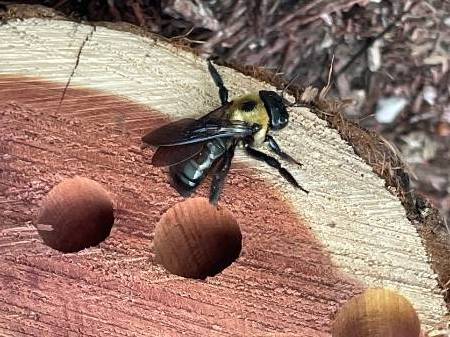Carpenter Bee

This week, we had a surprise visitor in our office, a Carpenter bee. An individual brought in a chunk of cedar branch with large (1/2”) diameter holes, as shown in the picture. The next morning, this little lady watched us out of one of the holes in the branch. These bees are native to Kansas and can be an excellent pollinator and a pest for homeowners. Carpenter bees are often mistaken for bumble bees because they are similar in size and appearance; however, carpenter bees have a smooth, shiny abdomen while bumblebees are very fuzzy. You can also tell them apart by their nesting habitats. Carpenter bees nest in cavities and tunnels they create in the wood, while bumble bees nest in colonies underground. Carpenter bee queens will excavate a series of tunnels approximately ½” in diameter in dead logs, stems, or other wooden structures, including wooden siding or wooden decks, to create chambers to house their young. This nesting habit can put them at odds with humans as they can destroy homes and decks over time. The female bees can excavate an inch of tunnel a day, and each succeeding generation will often use the same nest, slowly creating an extensive, elaborate tunnel system. If the nest becomes big enough, multiple queen bees can use it. There will still be one “primary” queen, laying eggs and foraging for food while the “subordinate” queens defend the nest. These bees typically live for one year; however, subordinate queens can live up to three years in large nests since they aren’t doing as much labor. Adult carpenter bees overwinter in the nest and start foraging sometime in April.
Carpenter bees are an important native pollinator; however, they can become a pest of homeowners in some situations. If bees start to use your home as a nest, there are a couple of options. First, treat the wood with paint or stain, which can deter bees from constructing a nest in your location. You can also provide alternative nesting solutions in your area, such as untreated pine or cedar, to lure female bees away from structures. If a nest is already on the site, paint will not deter them. Carpenter bee traps can relocate bees to a new location far away, or insecticidal treatments may be the only option. The best treatment method is to spray the tunnels at night with a bee and wasp spray to immobilize the bees. Another option is to use an insecticide formulated as dust to puff into the tunnels. Fill the tunnel with caulk or a wooden dowel several days later to ensure another bee doesn’t use the already-built tunnels. Paint the covered hole if possible to further deter bees.

Have questions? Contact our office where our Horticulture Extension Agent will assist you with questions.
Phone: (316) 321-9660
Email: callae@ksu.edu